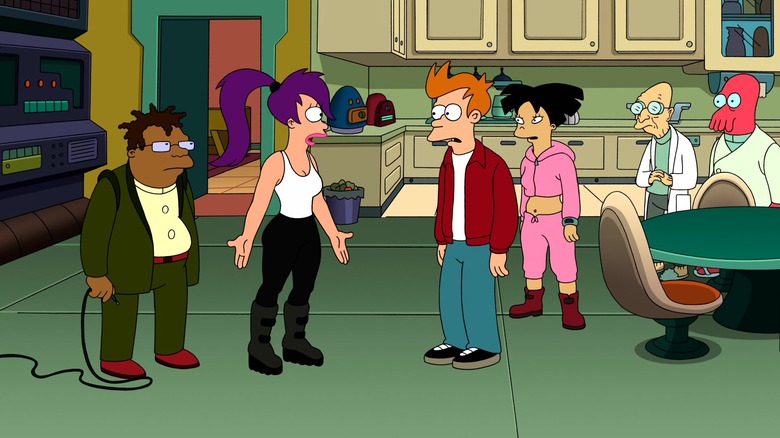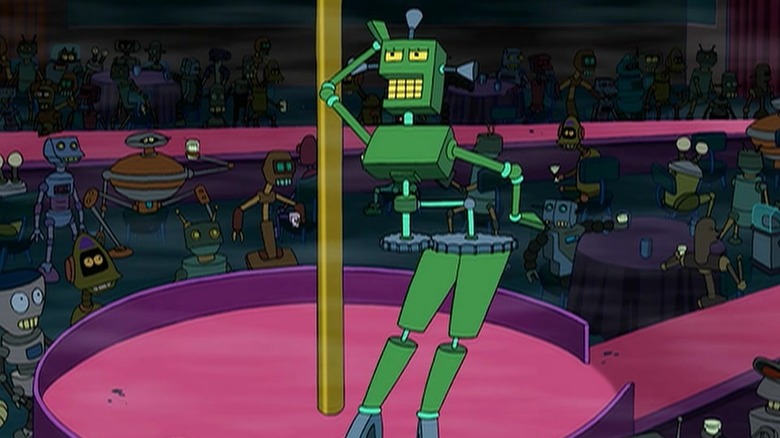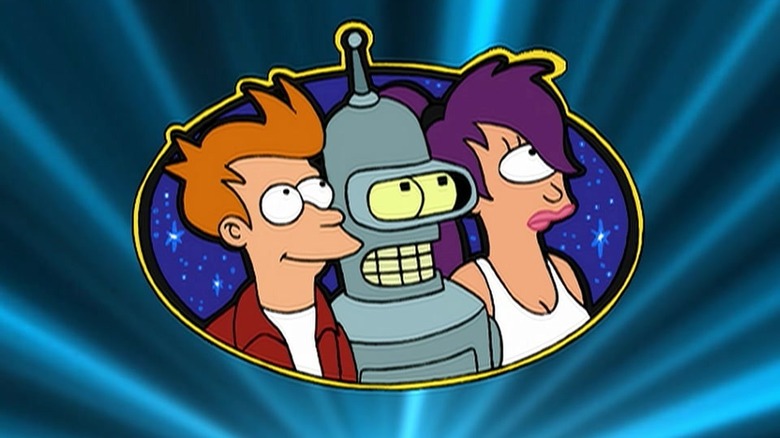We may receive a commission on purchases made from links.
Back in 1990, when “The Simpsons” was only in its second season, show creator Matt Groening had already begun floating ideas for a sci-fi/comedy companion series. He even went on record with the corollary that his new show would be to “The Simpsons” what “The Jetsons” was to “The Flintstones.” Groening spent several years turning the idea over in his head before finally approaching “Simpsons” writer David X. Cohen about the possibility of co-creating something together. The two slowly developed many ideas and invented a cast of new characters to live in the futuristic, robot-and-alien-crowded world of A.D. 3000. Some of the original titles for the series included “Aloha, Mars!” and “Doomsville.” The show was also initially conceived to be bleaker and more dystopian than it ended up being; every corner was outfitted with a coin-operated suicide booth.
Eventually, Groening and Cohen found a happy medium and “Futurama” debuted on March 28, 1999. The characters, like on “The Simpsons,” were based on Groening’s designs and animated after his drawing style. Unlike on “The Simpsons,” however, the characters would sport realistic flesh tones; Cohen and Groening have said on various “Futurama” DVD commentary tracks that “The Simpsons” is a fictional sitcom while “Futurama” takes place in the real world.
Cohen wrote an introduction for the new book “The Art of Futurama,” and he admitted that he is not much of an artist, preferring to stick to stories, characters, and incredibly oblique math jokes. He also confessed that when asked to draw, say, a unicorn, he essentially draws a four-stick-legged creature with a pointy bit where the horn might be. That’s as sophisticated a drawing as he’s able to produce. He compared his own drawing skills to that of a three-year-old. Cohen did, however, have one moment of creative input that he remains proud of: he designed a robot stripper.
David X. Cohen designed a robot stripper for Futurama
The robot stripper appeared in the episode “The Lesser of Two Evils” (February 20, 2000), wherein Bender (John DiMaggio) discovers he had an identical robot brother named Flexo. Bender and Flexo, finding they had identical interests in alcohol, cigars, petty theft, and other varied vices, decide to celebrate their similarities by going to Electric Ladyland, a robot strip club that offers “laptop dances.” A quick establishing shot shows what robot strippers look like in the early 3000s. One of them has electric fans for hands, giving the robot version of a fan dance, for instance.
The robot stripper that Cohen designed has a stationary upper torso and hips that grind around a gear at her waist, giving the impression that it’s slowly gyrating in a mechanically seductive fashion. Cohen knew his limited strengths as an artist, but he also knew that he could design a robot stripper for “Futurama,” provided it remain mostly cubical. In his own words:
“My style works well when the object I’m trying to draw is some kind of abstract ideal. I’m great at squares and also cubes. The one and only character I ever designed for ‘Futurama’ was a gear-based robot dancer at Bender’s favorite robot strip club. This is right in my wheelhouse! The entire joke is based on a character embodying the pure, unadorned concept of a gyrating hip gear; from mathematical model to page with no stops in between.”
The other robot strippers, as well as the many robots in the audience, were designed by Groening or one of the many members of the show’s creative staff.
Cohen still dictates design parameters for other artists on Futurama
Cohen admitted that, while he can’t draw, he can certainly boss around other incredibly talented artists and still get the kinds of designs he would like to see. “They have to listen to me!,” he joked. He added that, because he’s not the one doing the drawing, he can bark out vague descriptions and his talented team can interpret them as required. As he put it:
“The arrangement works better than you might think. For lack of other options, l’m forced to communicate in terms of emotions and adjectives. Can that space boat be junkier? Can Zoidberg’s pants be more depressing! Can Kif’s planet be squishier? I don’t give a lot of specifics on how to achieve these results, because … l … can’t! This gives the artists a lot of freedom. And left to their own devices, they produce consistently spectacular results. I honestly don’t know how they do it. It’s like everything is a cube to them!”
“Futurama” has been running on-and-off for the last 25 years, and the show’s designers have consistently turned out amazing work. Some of the designs remain deliberately rudimentary — Bender, for instance, is merely trashcan-shaped — but the show’s artists have also made the show’s backgrounds and aliens as complex as Groening’s style permits.
As for robot strippers, they continue to appear on “Futurama” regularly. One might recall Fanny (Tress MacNeille), the wife of the Don Bot (Maurice LaMarche), appeared in “Into the Wild Green Yonder.” Just don’t ask how — or even why — robots have sex on “Futurama.” It’s never clearly explained.




Leave a Reply